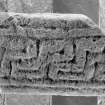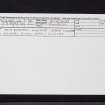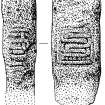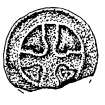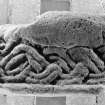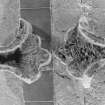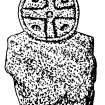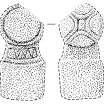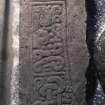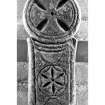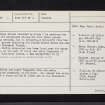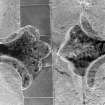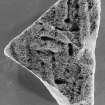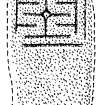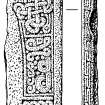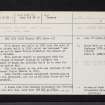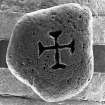Great Cumbrae Island, Millport, Mid Kirkton
Carved Stone (Early Medieval), Cemetery (Medieval) - (Post Medieval), Church (19th Century), Cross(S) (Early Medieval), Cross Slab(S) (Early Medieval)
Site Name Great Cumbrae Island, Millport, Mid Kirkton
Classification Carved Stone (Early Medieval), Cemetery (Medieval) - (Post Medieval), Church (19th Century), Cross(S) (Early Medieval), Cross Slab(S) (Early Medieval)
Canmore ID 40615
Site Number NS15NE 12
NGR NS 15756 55168
NGR Description Centred on NS 15756 55168
Datum OSGB36 - NGR
Permalink http://canmore.org.uk/site/40615
- Council North Ayrshire
- Parish Cumbrae
- Former Region Strathclyde
- Former District Cunninghame
- Former County Buteshire
Kirkton 3 (St Columba), Great Cumbrae, cross-slab
Measurements: H 0.63m, W 0.21m to 0.28m, D 0.10m
Stone type: white sandstone
Place of discovery: NS 15756 55168
Present location: in the Cathedral of the Isles at Millport (Canmore 120846).
Evidence for discovery: first recorded in the mid nineteenth century by Stuart.
Present condition: the base of the shaft is missing and the carving is somewhat worn.
Description
This finely carved disc-headed cross-slab is carved on both broad faces in such a way that the disc appears to be balanced on the concave top of its shaft. It bears four incised crosses, one within the disc and one within the shaft on both faces. Each broad face is bordered by a roll moulding.
On face A within this outer moulding, the disc has an inner moulding enclosing an equal-armed cross with widely expanded terminals and oval lozenge-shaped voids between the arms. The cross appears plain but there are traces of an inner moulding, and a central hollow may also have been enclosed by an incised circle. The top of the shaft has an inner roll moulding above a panel containing an encircled hexafoil cross, with a central hollow. There are incised curvilinear motifs above and below.
The disc-head on face C contains an encircled hexafoil cross identical to that on face A, and within the roll moulding of the shaft there is a panel containing an incised Latin cross. The arms of the cross and the base of its shaft terminate in crescents with spiral points.
Date range: early medieval.
Primary references: Stuart 1867, pl 74.2; Fisher 2001, 71, no 5.3.
Desk-based information compiled by A Ritchie 2019
Kirkton 6 (St Columba), Great Cumbrae, carved stone fragments
Measurements: L 0.56m, W 0.18m, D 0.08m
Stone type: sandstone
Place of discovery: NS 15756 55168
Present location: in the Cathedral of the Isles at Millport (Canmore 120846).
Evidence for discovery: first recorded in the mid nineteenth century by Stuart
Present condition: worn and broken.
Description
These two conjoining fragments represent part of a long narrow panel, carved on one face only, which may be of architectural origin. Within a double roll moulding is a fret pattern.
Date range: early medieval.
Primary references: Stuart 1867, pl 74.1; Fisher 2001, 70-1, no 5.6.
Desk-based information compiled by A Ritchie 2019
Kirkton 9 (St Columba), Great Cumbrae, cross-slab fragment
Measurements: diam 0.29m, D 0.03m
Stone type: sandstone
Place of discovery: NS 15756 55168
Present location: in the Museum of the Isles at Millport.
Evidence for discovery: first recorded in the mid nineteenth century by Stuart. It was built into a garden wall at Millburn House until 1974, when it was given to the museum in Millport.
Present condition: very weathered and the lower area of face A has flaked away. The shaft is missing.
Description
This was the disc-shaped head of a small cross-slab. It is carved on one face with a roll-moulded outer edge and an inner concentric roll moulding enclosing a cross. The cross is outlined by roll moulding and is otherwise plain, and its lower arm appears shorter than the others. Between its arms are triquetra knots.
Date range: early medieval.
Primary references: Stuart 1867, pl 74.3; Fisher 2001, 72, no 5.9.
Desk-based information compiled by A Ritchie 2019
Kirkton 10 (St Columba), Great Cumbrae, cross slab
Measurements: H 0.48m, diam head 0.23m, W of base 0.34m, D 0.10m
Stone type: sandstone
Place of discovery: NS 15756 55168
Present location: in the Museum of the Isles at Millport.
Evidence for discovery: first recorded in the mid nineteenth century by Stuart. It was at Millburn House until its donation to the museum sometime after 1975.
Present condition: worn and the edges of the base or shaft are damaged.
Description
This small disc-headed cross has a plain gabled base, and a head with a roll moulded frame. An equal-armed cross is incised within the disc, plain apart from a central dot and ring, and there are oval hollows between the arms.
Date range: early medieval.
Primary references: Stuart 1867, pl 74.5; Fisher 2001, 72, no 5.10.
Desk-based information compiled by A Ritchie 2019
Kirkton 1 (St Columba), Great Cumbrae, cross-incised stone
Measurements: L 0.35m, W 0.31m, D 0.12m
Stone type: igneous
Place of discovery: NS 15756 55168
Present location: in the Cathedral of the Isles at Millport (Canmore 120846).
Evidence for discovery: first recorded in the mid nineteenth century by Stuart.
Present condition: good.
Description
This rounded boulder is firmly incised on its upper surface with a cross with expanded terminal to the arms and to the base of the shaft.
Date range: early medieval.
Primary references: Stuart 1867, pl 74.8; Fisher 2001, 70-1, no 5.1.
Desk-based information compiled by A Ritchie 2019.
Kirkton 2 (St Columba), Great Cumbrae, cross-incised stone
Measurements: L 0.43m, W 0.28m
Stone type: whinstone
Place of discovery: NS 15756 55168
Present location: lost.
Evidence for discovery: first recorded in the late nineteenth century by Hewison at Millburn House.
Present condition: unknown.
Description
This boulder was incised with a cross.
Date range: early medieval.
Primary references: Hewison 1893, 284, no 7; Fisher 2001, 70, no 5.2.
Desk-based information compiled by A Ritchie 2019
Kirkton 4 (St Columba), Great Cumbrae, cross-slab
Measurements: H
Stone type:
Place of discovery: NS 15756 55168
Present location: lost.
Evidence for discovery: first recorded in the mid nineteenth century by Stuart.
Present condition: unknown.
Description
This was an oblong slab incised with an equal-armed cross with a central lozenge, enclosed within a fret-like pattern of straight lines.
Date range: early medieval.
Primary references: Stuart 1867, pl 74.4; Fisher 2001, 70-1, no 5.4.
Desk-based information compiled by A Ritchie 2019
Kirkton 5 (St Columba), Great Cumbrae, carved stone
Measurements: L 0.43m, W 0.28m, D 0.09m
Stone type: white sandstone
Place of discovery: NS 15756 55168
Present location: in the Cathedral of the Isles at Millport (Canmore 120846).
Evidence for discovery: first recorded in the mid nineteenth century by Stuart.
Present condition: broken and worn.
Description
This fragment is carved with a plait of two median-incised cords. It may have been an architectural piece.
Date range: early medieval.
Primary references: Fisher 2001, 70-1, no 5.5.
Desk-based information compiled by A Ritchie 2019
Kirkton 7 (St Columba), Great Cumbrae, carved stone
Measurements: H 0.76m, W 0.34m, D 0.24m
Stone type: sandstone
Place of discovery: NS 15756 55168
Present location: lost.
Evidence for discovery: first recorded in the late nineteenth century and again in 1983 in the garden of Millburn House, but not seen since then.
Present condition: unknown.
Description
This very worn and damaged stone was part of a pillar carved on one broad and one narrow face with simple and heavy key pattern, and on face A with a basal line of pellets.
Date range: early medieval.
Primary references: Hewison 1893, 284, no 8; Fisher 2001, 71, no 5.7.
Desk-based information compiled by A Ritchie 2019
Kirkton 8, Great Cumbrae, architectural carved stone
Measurements: L 0.96m, W 0.34, D 0.10m
Stone type: sandstone
Place of discovery: NS 15756 55168
Present location: Glasgow Art Gallery and Museum (1-’32).
Evidence for discovery: found buried in the churchyard sometime prior to 1907 and kept in the manse garden until 1931, when it was acquired by Waddell and taken the following year to Glasgow Art Gallery and Museum.
Present condition: broken, battered and worn.
Description
This slab is carved on one broad face and one long narrow face, and the back has been left quite rough. The other long narrow face is damaged. Face A has a plain border round two carved panels: on the left is a rectangular panel containing two simple twists of cord set vertically, with three pellets between the twists. The main panel has a roll moulding frame and is divided into two inner panels: first a rectangular panel filled with three different types of loop with pellets between them, and then a panel containing a cruciform knot with more pellets and cord fillers.
The arrangement of the ornament implies that half or slightly less of the original slab has survived: the upper margin rises over the cruciform knot but then drops only a little, which suggests that the knot was not the centre of the design.
Face B has roll-moulded edges and a long panel of continuous T-fret, which is constricted part way along, where the lower roll moulding makes a curve inwards.
This slab is thought to have acted as a decorative panel over an opening, probably a doorway, in such a way that face B was the underside.
Date range: early medieval.
Primary references: Waddell 1932, 411-12; Batey 1994, 67-9; Fisher 2001, 71-2.
Desk-based information compiled by A Ritchie 2019
Kirkton 11 (St Columba), Great Cumbrae
Measurements: H 0.75m
Stone type:
Place of discovery: NS 15756 55168
Present location: lost.
Evidence for discovery: first recorded in the mid nineteenth century by Stuart.
Present condition: unknown.
Description
This was a disc-headed cross with a shouldered base, and it was carved on both broad faces: on face A the disc had an inner incised line and the ‘shoulder’ of the base bore an incised panel of zig-zag, while on face C bore an outline saltire cross with a rectangular centre.
Date range: early medieval.
Primary references: Stuart 1867, pl 74.8; Fisher 2001, 72, no 5.11.
Desk-based information compiled by A Ritchie 2019
Field Visit (9 November 1964)
The siting of the church on the OS 25" was confirmed by the sexton who has encountered foundations while digging in the area. The cross fragments Nos.2 and 8 and part of No.1 are at the cathedral, Nos. 3, 4 and 5 are at Millburn House (NS 1586 5480); the remainder could not be traced. The stones are lying loose with the exception of No.3 which is cemented on top of a wall at Millburn.
The cross-slab found near the manse garden is reputed to be at Skelmorlie Aisle (NS25NW 13) Largs, but was not seen there.
Visited by OS (JTT) 9 November 1964.
Desk Based Assessment (1964)
NS15NE 12 15775 55161.
(NS 15775 55161) Church (NR) (Site of)
OS 6" map (1938)
This church was built in 1802 upon the site of the church build in 1612, which had replaced "ane kirk callit Sanct Colmis Kirke", or the church of St Columba. This earlier church is associated with the "chapel of Cumray" granted in 1318; and the Church of Maura was probably built on or near the site before 642. The last church on the site was replaced by the present Parish Church in 1837.
Some 7th-8th century sculptured crosses, dug up in the graveyard, are now at Millburn House and the Cathedral.
W Lytteil 1886; J K Hewison 1893
Three stones recorded by Allen (he mentions two Class III sculptured stones and four other stones bearing crosses, but no ornament, at Millport) from the burial ground adjoining the Parish Church Manse are now in the Cathedral Church.
A Celtic cross-slab has been found neaar the manse garden, in the wall of which are other fragments of stone, similarly carved.
J J Waddell 1932; J R Allen and J Anderson 1903; J Stuart 1876
A shale disc from Cumbrae churchyard was obtained by the National Museum of Antiquities of Scotland (NMAS) (FN 80) in 1893.
NMAS Accession Card Index and Attendants Catalogue
There are eight fragments from six early Christian monuments at Millport. All except two which are at a house called Millburn are at the Cathedral.
C L Curle 1964
Information from OS.
Reference (2001)
This island is separated from the Ayrshire coast by a channel which at the N end is only 1.7km wide, and unlike Bute, some 7km to the W, it belonged to the medieval diocese of Glasgow rather than the Isles. It measures 5.3km from N to S by 3.5km, rising to a maximum height of 127m, and contains fertile areas and sandstone of good quality. The medieval church dedicated to St Columba (a) stood in the burial-ground at Kirkton, on a low spur that divides Millport Bay from the W coast.
The stones described below are believed all to have come from this site (b). Five (nos.1, 3, 5, 6) are in the episcopal Cathedral of the Isles (NS 1658 5524), to which they were presented by the Earl of Glasgow in the middle of the 19th century; two (nos.9, 10) are in the Museum of the Cumbraes at Millport (NS 1641 5503); one (no.8) is in Glasgow Art Gallery and Museum; and four (nos.2, 4, 7, 11) are lost.
(1) Irregular igneous boulder with rounded edges, 0.35m by 0.31m and 115mm thick. On the smooth flat face there is a boldly incised cross, 130mm high by 120mm in span. It is of Latin form, the shaft being about 20mm longer than the top arm, and has triangular terminals, the top and left ones being slightly forked. The cross is cut with V-section grooves showing pock-marks, and the terminals are sunk to a depth of about 10mm and have bevelled sides.
(Stuart 1867, pl.74, 8; Hewison 1893, 1, 283 (no.3); Allen and Anderson 1903, 3, 417 (no.4); Curle, C L, in PSAS, 95 (1961-2), 224 (no.2) and pl.14, 4; Cross 1984, C3).
(2) Hewison describes a 'pear-shaped whinstone', 0.43m by 0.28m at the top and bearing an incised Greek cross, which was at Millburn House in 1893.
(Hewison 1893, 1, 284 (no.7); Cross 1984, C14).
(3) Upper part of a pillar of fine-grained white sandstone, 0.63m high and tapering in thickness from 105mm at the foot to 95mm. It comprises a disc-head 0.28m in diameter set into a shouldered shaft with slightly concave sides, 0.21m in width at the narrowest point and 0.24m below the head. The edges of both the disc and the shaft are rounded. The lower part of face (b) is deeply flaked, but otherwise it is less worn than face (a).
The disc on face (a) has a double roll-moulded margin enclosing an equal-armed cross 0.21m in span. This has curved arms with beaded edges and bevelled sides, separated by flat-bottomed sunken 'petals' and having a central hollow 10mm across and 12mm deep within traces of a moulded surround. Both edges of the shaft have 30mm edge-mouldings which at the top enclose a double moulding following the lower curve of the disc-head. The shaft contains a central hexafoil with incised curvilinear ornament above and below and small roundels in the spandrels. The hexafoil, enclosed by a 140mm incised circle, has oval pocked petals whose tips are linked by pocked curves and there is a central hollow. Above the hexafoil there is a crescent whose terminals may have spiralled out, as on face (b), but are much worn, and in the left spandrel there are traces of a small roundel or spiral, possibly linked to the base of the crescent. This is repeated in the lower left spandrel, and the incomplete lower crescent contains two roundels or spirals forming an upward-pointing pelta.
The head of face (b) has a similar double moulding enclosing a hexafoil 0.2m in diameter. It resembles that on face (a) but is more deeply sunk, and the axis of the vertical petals is inclined very slightly to the left. The edge-moulding of the shaft, which returns below the disc-head, encloses a Latin cross, 120mm high by 85mm in span, firmly incised with a V-section groove. The arms have long crescentic terminals whose ends spiral inwards at the top and foot, to form peltae, and outwards in the side-arms.
(Stuart 1867, pl.74, 2; Hewison 1893, 1, 283 (no.2); Curle 1964, 223-4 (no.1) and pl.14, 1-3; Cross 1984, C4).
(4) Roughly rectangular slab, about 0.49m by 0.27m. The only evidence for its ornament is Stuart's engraving, which shows an incised cross with a central lozenge, having at the top and foot barred terminals of the same span as the transom. It is framed by vertical and horizontal grooves to form a fret-like pattern.
(Stuart 1867, pl.74, 4; Allen and Anderson 1903, 3, 413-14 (no.2); Cross 1984, C10).
(5) Fragment of white sandstone from the angle of a slab, 0.43m by 0.28m and tapering in thickness from 105mm at the broken centre to 80mm at the edges. A 35mm moulding runs along the two preserved edges, and within it at the longer edge there is a strip of broad double-beaded three-cord plait. This appears to terminate rather than returning, although there is a possible pellet in the damaged area within the shorter edge. The remainder of the slab is plain, with a roughly-scalloped edge defined by the curves of the interlace.
(Curle 1964, 224 (no.4) and pl.15, 1; Cross 1984, C5).
(6) Part of a narrow rectangular slab of sandstone, 0.56m by 0.18m and 75mm thick (c). It is shown in Stuart's engraving as broken across obliquely, and the smaller end-fragment is now itself broken and laminated in thickness, although one return angle is preserved. It is carved on one face with double mouldings, shown by Stuart as returning at the end although the angle is now too damaged for this to be verified. Within the mouldings it is filled with a fret composed of Z-shaped units with median grooves (RA 888). Occasional pock-marks are preserved, but the surface is much worn with some upstanding veins.
(Stuart 1867, pl.74, 1; Hewison 1893, 1, 283 (no.4); Curle 1964, 223-4 (no.1) and pl.14, 6; Cross 1984, C1).
(7) Pillar or cross-shaft fragment of sandstone, recorded in the garden of Millburn House (NS 1590 5479) in 1983 but not now identifiable. It measured 0.76m in height by 0.34m in width and 0.24m in thickness, and one face and the left edge were carved. The face (a) had a double margin whose inner moulding returned 0.3m above the foot to enclose a row of seven pellets, above which was a simple key-pattern formed by a series of parallel bars with hooked ends (variant of RA 887). The upper part was much worn but showed traces of a possible circular motif. The left edge (b) was also much worn and lichen-stained but showed traces of interlace which appears to have included a cruciform knot enclosing a pellet.
(Hewison 1893, 1, 284 (no.8); Cross 1984, C6 and pls.49-50).
(8) Slab of sandstone, found buried in the old churchyard some years before 1907 and subsequently preserved in the garden of the manse, now Kirkton House, which lies NW of the churchyard (d). It was acquired by J J Waddell in 1931 and lent to Glasgow Art Gallery and Museum, although this location was not published until 1994 (e).
The carving is a rectangular slab of sandstone, broken at one end and having one irregular side, which measures 0.96m by 0.32m to 0.36m , and 100mm in thickness. It is carved on one face and one edge, and the design of the ornament as well as the roughness of the back and one side supports the suggestion that it may have been a lintel (f). The face has a plain 50mm to 60mm margin, which returns at the left end with a width of 70mm but at the upper side varies from 100mm to 30mm to match the curving edge of the main panel. At the left there is a vertical panel containing two twists, with slight traces of double-beading, and with single pellets in three of the spaces between them. It is separated by a narrow bar from the moulding that encloses the main carved area, itself divided into two surviving panels. One of these is almost rectangular, but the moulding along the top curves to accommodate a higher panel with a cruciform knot which presumably occupied the centre of the slab (g). The left panel has along the bottom a double-looped band with the triple-beaded or contoured outline typical of Anglo-Scandinavian animal-ornament, and what may be the head of the same creature, with a large eye and slightly upturned and elongated snout, appears at the base of the right panel. If this is so, it is overlain not only by the dividing moulding but also by two vertical bars with looped ends in the right part of the left panel. Along the top of the panel there is a narrower multi-looped band, and the interspaces of the panel, and some of the loops themselves, are filled with pellets. The top moulding of this panel is prolonged above the left limb of the adjoining cruciform knot as a double moulding whose lower member returns vertically to divide the panels. The top terminal of the knot rises above its frame, which to the right is treated as a meander pattern above the right limb and a T-shaped fret below it, although the damaged vertical moulding that separated it from the lost panel to the right is a straight bar (h). The knot is composed of two loops plaited at right angles and with their terminals forming Stafford knots, and it is surrounded by pellets resembling those found in Anglo-Scandinavian carvings in Cumbria (i).
The lower edge of the slab bears a continuous T-fret whose left edge is aligned with the edge of the small panel on the main face. This fret is interrupted 0.57m from the left end, where the lower margin curves up, presumably to avoid a flaw or break in the slab, and the spandrels are filled by two hollow triangles. The incomplete area to the right contains two straight-line spirals.
(Rubbing by Rev A Grierson, 1907 (NMRS, MS 28 (SAS 156); Waddell, J J, in PSAS, 66 (1931-2), 411-12; tracing by J J Waddell in NMRS, DC 17694; Batey, C, in Ritchie 1994, 67-9; Cross 1984, C9).
(9) Head of a disc-headed cross-slab or gravemarker of sandstone, 0.29m in diameter and broken in the lower part (j). It was formerly built into the top of a garden wall at Millburn House, and was donated to the Museum of the Cumbraes after being sold in 1974 (k). It is 30mm thick, with a slightly convex edge, and on one face it bears a cross within a ring 50mm wide and defined by bead-mouldings. The cross, which is 0.19m in span, has beaded edges and semicircular armpits. The centre of its head is set considerably below that of the circle so that the bottom arm, which is broken at its junction with the ring, is shorter than the top one. It may originally have continued, to overlie the ring or extend onto the base. In the lower angles there are triquetra knots, while the upper ones contain what may be birds, with little detail preserved.
(Stuart 1867, pl.74, 3; Hewison 1893, 1, 284, no.6; Allen and Anderson 1903, 3, 417, no.1; Curle 1964, 225, no.6, fig.1 on p.225 and pl.15, 4; Cross 1984, C7).
(10) Disc-headed gravemarker of sandstone, formerly at Millburn House and donated to the museum by a former owner of that property after 1975. The head is 0.23m in diameter and the overall height is 0.48m, while the gabled base is 0.34m wide and tapers in thickness from 105mm at the foot to 90mm at the head. The base is damaged at the right edge and bottom left corner, but appears always to have been roughly dressed and was presumably earthfast. The head has an edge-moulding which encloses an equal-armed outline cross with a circular central expansion containing a sunken 20mm boss. The arms are irregular in width and the top and right ones are splayed. The two upper quadrants have oval hollows enclosing oval bosses, while the lower quadrants have deeper oval hollows.
(Stuart 1867, pl.74, 5; Hewison 1893, 1, 284, no.5; Allen and Anderson 1903, 3, 417, no.2; Curle 1964, 224-5, no.5, and pl.15, 2; Cross 1984, C8).
(11) Disc-headed gravemarker, broken obliquely in the upper part of the disc. Stuart's engraving shows a disc 0.24m in diameter which was supported on a tapered 'collar' above a rectangular base 0.25m wide, the overall height being 0.75m. On one face (a) the disc was plain except for a margin, but the 'collar' was decorated with a slightly curved panel containing zig-zag ornament and was distinguished from the base by a groove or rebate. On face (b) the disc had no margin and the arms of an outline saltire cross with round armpits extended to the perimeter. Within the outline cross there was an incised one of similar shape whose arms diverged to frame a central rectangle or lozenge. The lower edge of the disc was distinguished from the 'collar', which may have been set back slightly from the base below.
(Stuart 1867, pl.74, 6; Cross 1984, C11).
Footnotes:
(a) About 1316 this was granted to Paisley Abbey as a chapel attached to the parish church of Largs, also dedicated to St Columba (Origines Parochiales, 1, 89-90). Monro (Western Isles, 48) refers to 'St Colms Kirk', and in the 16th century it was regarded as a parish church (Cowan, Parishes, 42).
(b) W Lytteil (Guide-Book to the Cumbraes (1886), 81-2) says that stone (1) was found in the 1850s between The Garrison and St Andrew's Church (NS c.1646 5507).
(c) There is no evidence to support Curle's identication of this as the shaft of the 'Trahoun' cross (no.12).
(d) Note on rubbing by Rev A Grierson, 1907 (NMRS, MS 28 (SAS 156)). Waddell stated that it was found 'adjoining the manse garden' and that other carved fragments were built into the garden-wall (Waddell 1932, 412). Cross's statement that Millburn House was used as the manse at this time (Cross 1984, 157) is contradicted by the 1st (1855/57) and 2nd (1895/1906) editions of the OS 6-inch map (Argyll and Bute, sheet 216).
(e) Batey, C, in Ritchie 1994, 67-9.
(f) Ibid., 69. In the following description it is assumed that the slab stood with the main face vertical and the carved edge below it.
(g) The surround of the panel is not sufficiently symmetrical to allow detailed reconstruction of the slab.
(h) The apparent discrepancy in the 1907 rubbing in this area, noted by Batey (op. cit., 68), appears to be due to tentative treatment of the broken edge by an inexperienced rubber (cf. accompanying letter to 'Mr Stevenson').
(i) Bailey and Cramp 1988, figs.67-8, 256, 551-4, 606-8.
(j) Mrs Curle stated that the shoulders of the base were preserved (Curle 1964, 225), but her pl.15, 4 appears to show the break in its present position.
(k) Campbell, J R D, Millport and the Cumbraes (1975), 107.
I Fisher 2001, 70-2.





























